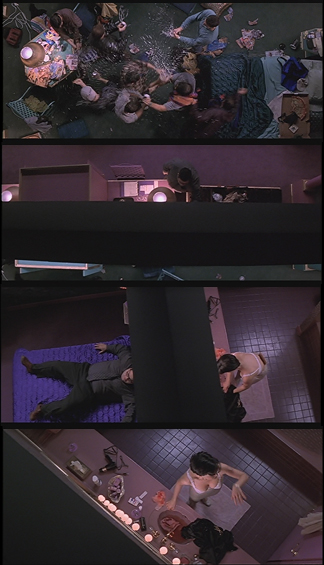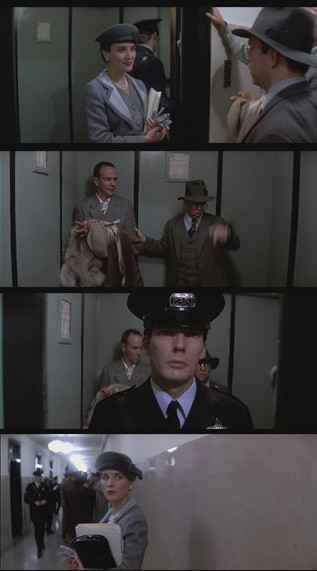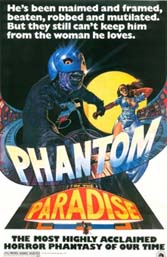SPECIFICALLY NAMES SNAKE EYES
 You may recall a year ago, when the Globe and Mail's Rick Groen reported that Gaspar Noé was excitedly asking around at the 2009 Toronto International whether anyone had seen Brian De Palma in the audience for Noé's Enter The Void. This weekend, Enter The Void has finally opened in select North American theaters, and Noé has been mentioning De Palma to interviewers as a key influence on his latest film, which he worked on for about a decade. Discussing his film with Filmmaker Magazine's Brandon Harris this past summer, Noé stated he had in mind Kenneth Anger's Inauguration Of The Pleasure Dome "or some of Brian de Palma’s movies," adding, "I really like aerial shots and everything in the one with Nicholas Cage. Snake Eyes I think." Harris then confirmed the movie title, and added that "Snake Eyes also has a bravura long tracking scene," to which Noé replied, "A good one."
You may recall a year ago, when the Globe and Mail's Rick Groen reported that Gaspar Noé was excitedly asking around at the 2009 Toronto International whether anyone had seen Brian De Palma in the audience for Noé's Enter The Void. This weekend, Enter The Void has finally opened in select North American theaters, and Noé has been mentioning De Palma to interviewers as a key influence on his latest film, which he worked on for about a decade. Discussing his film with Filmmaker Magazine's Brandon Harris this past summer, Noé stated he had in mind Kenneth Anger's Inauguration Of The Pleasure Dome "or some of Brian de Palma’s movies," adding, "I really like aerial shots and everything in the one with Nicholas Cage. Snake Eyes I think." Harris then confirmed the movie title, and added that "Snake Eyes also has a bravura long tracking scene," to which Noé replied, "A good one."DE PALMA, ANGER, SCORSESE, VON TRIER, SCHRADER, SPIELBERG
Noé discussed his use of the camera as a point of view in the film with Prospect Magazine's Justin Villiers, explaining that Irreversible was a kind of experimental preparation for the new film:
I was working on Enter The Void many years before Irreversible, so I had been thinking about using such a free-flowing camera. It’s been done a lot before, but never in such an expanded way. There are many shots in Brian De Palma’s movies when the camera is flying over someone’s head, there is a similar shot in Taxi Driver, as well as in Lars Von Trier’s Europa or even in Mishima by Paul Schrader. There’s also, in Minority Report, one long shot that hangs above the set. I like those shots, but I’d always dreamed of having a movie where for one full hour you’d be flying above the sets. I’m happy that no one else did it before me.
LYNCH, RUSSELL, KUBRICK, KALATOZOV, LADY IN THE LAKE
When asked by IFC's Nick Schager where the central idea for Enter The Void came from, Noé laid out his influences from the beginning:
You don’t see many movies that really impress you during a lifetime, but “2001” was maybe my major cinematic shock. Then among the latest ones, “I Am Cuba” convinced me that the movie had to be shot with master shots. I saw it before shooting “Irreversible,” but “I Am Cuba” affected both “Irreversible” and this one.
Noé further elaborated to Schager on his inspirations for his use of point of view shots:
One day many years ago, maybe when I was in my late teens or early 20s, I took some mushrooms with friends, and then I went back home and they were playing “Lady in the Lake” on TV. That’s when I decided that the first part of the movie should be shot in first-person perspective. When it comes to the flashbacks, that doesn’t come from any other movie. I just thought that, in my own memories or in my dreams, I always see myself like a shadow on the right or left side, but I feel my presence. My dreams aren’t constructed like POVs, but that’s the way I perceive my own past or my own future or my own dreams. I’m sure that’s the same for most people, so I decided to leave it that way.When it comes to the actual visions, I was just inspired by all these accounts of out-of-body experiences, as well as images -- like I said -- from Brian De Palma, and “Zentropa” [the U.S. title of Europa] by Lars von Trier, who had some aerial shots that were really pretty.
DESCRIBING THE VISUAL, AND ADDING CRONENBERG
Noé also mentioned De Palma while discussing the difficulty of describing in words the visual experience of art:
There are movies that are more cinematic and movies that are more narrative in a literal way. I guess it's easier to talk about "Irreversible" or about "I Stand Alone" than to talk about this one, because maybe the best parts of the movie are some visual aspects that are more difficult to transfer to words. For example, my father is a painter, you see his paintings in the movie. The painter pretends to paint paintings that actually were my father's paintings. Sometimes I read reviews about his exhibitions and think, "How can people describe abstract or expressionist painting?" and yet, this movie had many references. When I started shooting it, I was thinking of course of "2001: A Space Odyssey," of "Videodrome," of "Altered States," some shots in Brian De Palma's movies where the camera is floating above or "I Am Cuba" for the long master shots. But also, I had in mind Kenneth Anger's "Inauguration of the Pleasure Dome" and "Eraserhead," which are dreamy movies that are very hard to describe. You cannot describe colors, not when you have 20 colors, so you just say "it's colorful." I knew this movie should be more visual than the previous ones, but that's also why people are more pissed off, because for some people, it's too visual, too experimental. I got much better reviews than I've ever had in my life with this one, but I also got the worst reviews I've ever had with this one. One (critic) said, "This is the worst piece of sh*t that has ever been shown in the Cannes Film Festival" just because of the flickering effects, the out-of-focus effects, at a point make you feel very stoned. For people who don't like feeling stoned, then they refuse the experience and they feel as if they've been brought somewhere they didn't want to go.
You can see some of the shots being discussed above on a YouTube video put together by BUF, the company that did many of the visual effects in the film.
(Much thanks to Peet!)







 Brian De Palma turns 70 today, and he appears to be celebrating by attending the 2010
Brian De Palma turns 70 today, and he appears to be celebrating by attending the 2010 
 With Armond White set to be one of the guests on tonight's Carrie-related episode of the
With Armond White set to be one of the guests on tonight's Carrie-related episode of the 
 At the Venice Film Festival today,
At the Venice Film Festival today,